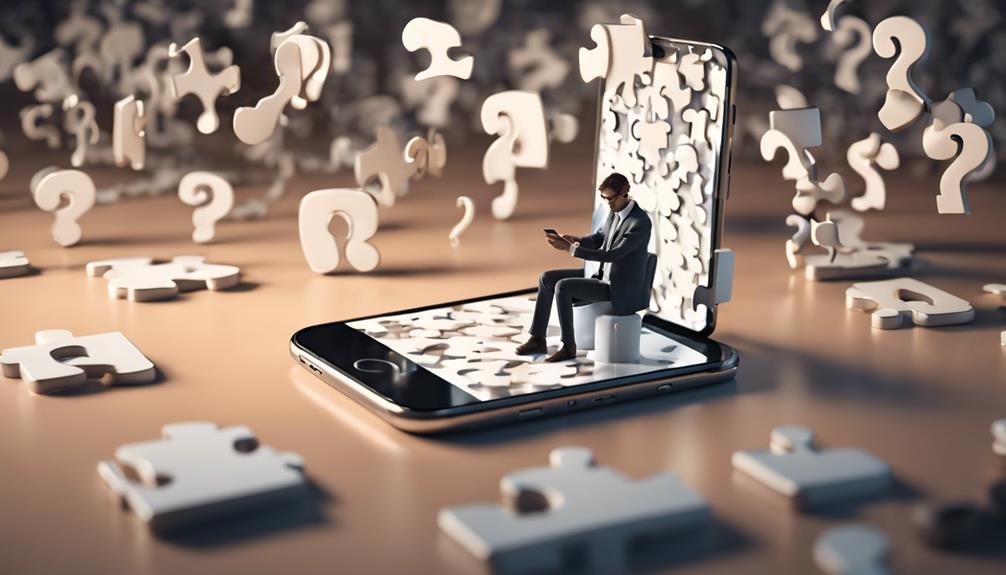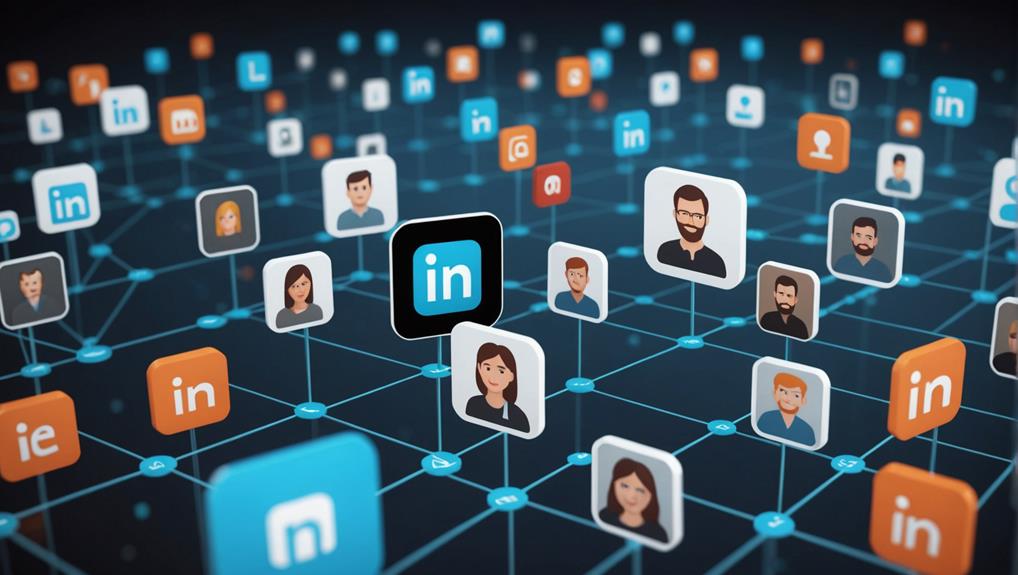
When you delete a message on LinkedIn, the recipient won't know as they aren't notified, and the message remains visible in their inbox. This means you can manage your own message stream without affecting what others see, allowing for a cleaner, more organized communication flow for you, while keeping the interaction intact for them. This functionality helps maintain your professional discretion and privacy, ensuring that your LinkedIn messaging stays on point and relevant to your networking goals. There's more to understand about managing your LinkedIn interactions effectively and protecting your professional image online.
Understanding LinkedIn Messaging

LinkedIn's messaging feature allows you to communicate directly with other professionals in your network. It's a powerful tool that helps you build and maintain connections, fostering a sense of belonging in your professional community. You can reach out for advice, share opportunities, or simply check in with colleagues, all within a platform that's designed for professional growth.
When you send a message on LinkedIn, you're not just passing information; you're also engaging in a professional exchange that enhances your presence in the industry. Each conversation you initiate or respond to can reinforce your relationships and expand your influence. This interaction is pivotal in cultivating a network that supports your career aspirations.
Moreover, LinkedIn messages often serve as the first point of contact in professional relationships. Whether you're seeking mentorship, exploring job opportunities, or inviting someone for a collaborative project, your approach in these messages can set the tone for future interactions. It's your chance to make a positive impression, demonstrating your professionalism and genuine interest in the person you're contacting.
What Happens When Deleting?
When you delete a message on LinkedIn, it's removed from your inbox but not from the recipient's. This action helps you manage and organize your conversations without affecting the other person's record of the interaction. You're essentially clearing your own space, much like tidying up your part of a shared workspace, while leaving theirs untouched.
This selective deletion ensures that your LinkedIn experience remains streamlined and focused. It's just like when you're part of a community or team; you handle your contributions and space, ensuring it aligns with your needs and preferences, without disrupting others' setups. Deleting a message doesn't erase the history between you and the recipient; it simply tidies up your view, allowing you to concentrate on the messages that matter most to you right now.
Visibility of Deleted Messages

You might wonder if others can see that you've deleted a message on LinkedIn. After all, maintaining professionalism and ensuring smooth communication are key in reinforcing your place within your professional community. Here's what you need to know: when you delete a message, it disappears from your inbox, but LinkedIn doesn't currently inform the other person that a message has been deleted. This means they won't receive a notification or see a placeholder indicating that something was removed.
This setup helps you manage your conversations more discreetly, contributing to a tidier messaging environment without openly displaying every action you take. It's akin to quietly tidying up your space in a shared office—nobody needs to know every detail, yet everyone enjoys the streamlined, organized environment.
Recipient Notifications Explained
Let's explore how LinkedIn handles notifications when you delete a message. You're part of a professional community where every action you take can influence how you're perceived. When you delete a message on LinkedIn, it's natural to wonder if the recipient gets notified about this change. It's crucial for maintaining your professional image and ensuring you're seen as considerate and respectful in your digital interactions.
Here's the straightforward answer: LinkedIn does not notify the recipient when you delete a message from your end. This means you can manage your messages discreetly without worrying that it might alert or offend the other person. It's like having the ability to tidy up your part of the conversation without making waves. This feature supports a sense of control and privacy in your communication, aligning with the platform's standards for professional interaction.
Managing Sent Messages

Managing your sent messages on LinkedIn allows you to keep your conversations relevant and organized. It's essential to ensure your message thread mirrors your current professional interactions and maintains a clear, purposeful direction. You're part of a vibrant community on LinkedIn, and how you manage your communications can reflect your professional etiquette and attention to detail.
When you send a message, it's not just about making a connection; it's about fostering a relationship that can grow. Keeping your message history tidy and up-to-date makes it easier for you to follow up on past discussions. You'll find it more straightforward to remember key details about your connections, which in turn, makes your replies more personal and engaging.
If you ever need to backtrack and check details from a previous conversation, having a well-managed message list is invaluable. This organization isn't just about professionalism, it's about making your daily networking activities smoother and more effective. You're not just managing messages; you're nurturing potential opportunities.
Best Practices for Retraction
When retracting a message on LinkedIn, it's crucial to act quickly to ensure the recipient hasn't already seen it. You're part of a professional community where every action reflects on your personal brand, so it's important to handle message retraction with care.
First, consider the impact of your withdrawal. If it's a minor error, like a typo, weigh whether it's really necessary to delete the message or if a follow-up correction could suffice. Remember, your peers appreciate transparency, and a simple acknowledgment of a mistake can enhance your credibility rather than diminish it.
If you decide retraction is the best course, do it discreetly. Quickly delete the message and, if needed, send a new one with the correct information. This shows that you're attentive and committed to accurate communication.
Also, maintain a tone of professionalism in any follow-up messages. Apologize for any confusion and reaffirm your commitment to clear and effective communication. This approach not only helps in managing the current situation but also strengthens your relationships within the network, reinforcing your reputation as a thoughtful and proactive professional.
Handling Awkward Situations

Navigating awkward situations after deleting a LinkedIn message requires tact and careful communication. It's all about maintaining your connections and ensuring that everyone feels respected, even if a message needs to be pulled back. If you're worried someone noticed the deleted message, it's often best to address it directly. A simple, honest explanation can go a long way. You might say, "I deleted my earlier message because I realized it might not have come across the way I intended. I hope it didn't cause any confusion."
Remember, your aim is to preserve the relationship and foster a sense of mutual understanding. It's important that you don't ignore the situation if it's likely the other person has seen the message. Brushing things under the rug can make you seem insincere or untrustworthy. Instead, take the initiative to explain your actions and clarify your intentions.
This approach not only smooths over any potentially awkward moment but also strengthens your professional network. It shows you're someone who cares about how they communicate and interact with others. Ultimately, this can make your network feel more secure and connected, knowing that you handle such situations with grace and consideration.
Protecting Your Privacy Online
How can you ensure your online activities, especially on platforms like LinkedIn, remain private and secure? You're not alone in wondering this. In our connected world, maintaining privacy is crucial but can seem daunting. Here's how you can protect yourself and fit in with the community that values security.
First, regularly update your privacy settings on LinkedIn. This platform often updates its features, and with each change, your privacy settings might need a tweak. Stay informed and adjust accordingly.
Second, be mindful of what you share. It's tempting to post detailed professional achievements or personal milestones, but consider how this information could be viewed by outsiders. Share enough to engage and connect, not so much that your privacy is compromised.
Conclusion
In conclusion, when you delete a message on LinkedIn, it disappears from your side but remains visible to the recipient. There's no direct notification sent about the deletion, but staying mindful about what you send initially is key. If you've sent something by mistake, quickly addressing the error directly with the recipient might help manage the situation. Always prioritize your privacy by thinking twice before hitting send, ensuring your LinkedIn interactions remain professional and respectful.






